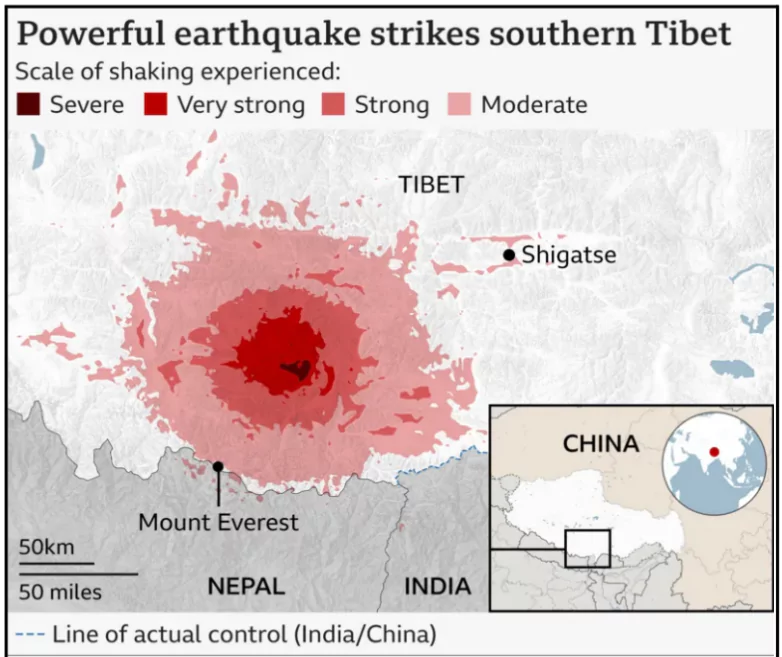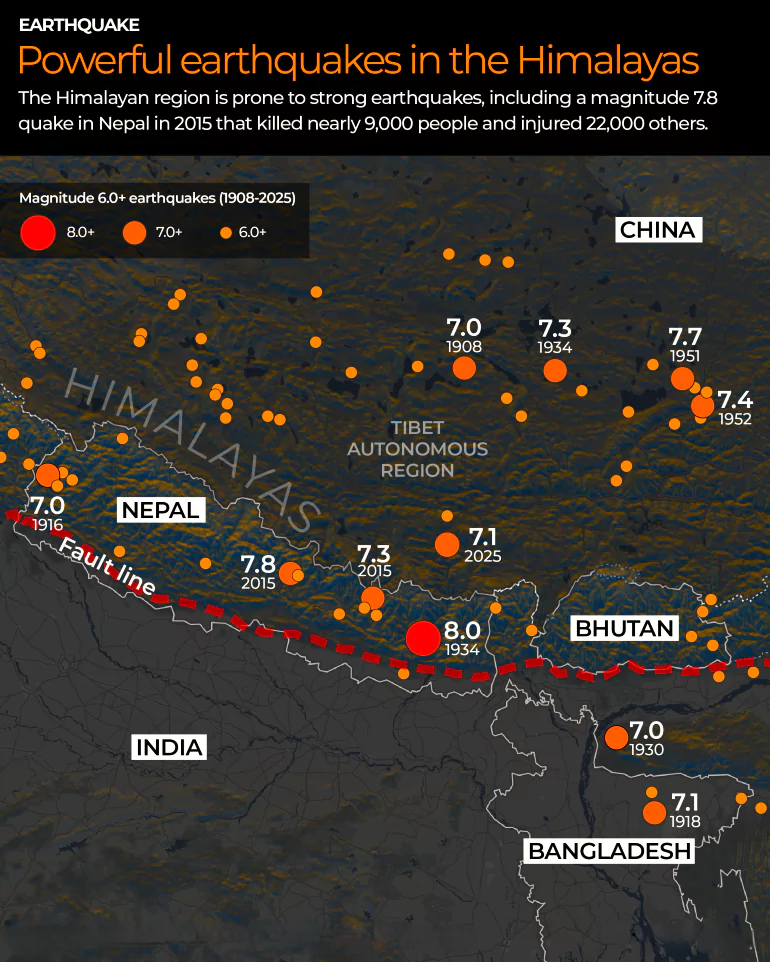An earthquake of magnitude 7.1 struck Tibetan China. The tremors of the powerful earthquake was felt in Nepal, Bhutan and parts of northern India.

- Epicentre: The epicenter of the earthquake is located 10 km below the Tingry county in the Shigatse region of Tibet (a spot around 80 km north-east of Mt Everest).
About the Shigatse Region of Tibet
- Population: Shigatse region is home to about 800,000 people.
- Cultural Importance: The Shigatse Region Capital city is the traditional seat of the important Panchen Lama of Tibetan Buddhism
- Panchen Lama is a key figure of Tibetan Buddhism whose spiritual authority is second only to the Dalai Lama.
- Tingry County: It is a ‘gateway’ to Mt Everest and the surrounding terrain and a popular tourist destination.
- Lhasa Terrane: The Lhasa block is a key geological region in southern Tibet, bounded by the Bangong-Nujiang suture zone in the north and the Indus–Yarlung Zangbo suture zone in the south
- Origin: The Lhasa Block was originally a part of Australia and East Africa plate, which diverged and joined the Eurasian plate during the Cretaceous period
- It collided with the Indian continent in the Cenozoic era
- Seismic Nature: It is positioned between the Qiangtang and Tethyan Himalayan terranes and experiences tectonic forces from the Indian-Eurasian plate collision.
- Rupture: The present earthquake is caused by a rupture in the Lhasa block in an area under north-south compression (causing crustal shortening and uplift) and west-east stress (leading to lateral crustal movements)
- Seismically Active: Since 1950, 21 earthquakes of magnitude 6 or higher have been recorded in the Lhasa terrane alone.
- The strongest of these occurred near Mainling in 2017 with a magnitude of 6.9,
Check Out UPSC NCERT Textbooks From PW Store
About Earthquakes in the Himalayan Region

- Formation: The Himalayan mountain range began forming around 40 to 50 million years ago with the collision of the Eurasian and Indian plates resulting in the uplifting of land.
- Upliftment: As both the continental plates were of similar density, there was no subduction initially causing the continental crust to thicken due to folding and faulting by compressional forces pushing up the Himalaya and the Tibetan Plateau.
- The continental crust here is twice the average thickness at around 75 km.
- Peculiar Tectonic Formation: The Indian plate is getting subducted under the Himalayas along the entire Himalayan range whereas the Eurasian plate is getting subducted under the Pamir mountains creating several convergence points for seismic forces along the entire region.
- Seismic Zone: As per the seismic zoning map prepared by the Bureau of Indian Standards (BIS), Majority of states in Himalayan regions fall in zone IV and V.
- Zone IV: Ladakh, the remaining part of J&K, Himachal Pradesh and Uttarakhand, parts of Haryana and Punjab, Delhi, and Sikkim fall in
- Zone V: Kashmir valley, the western part of Himachal Pradesh, the eastern part of Uttarakhand, part of northern Bihar, and all north-eastern states.
- Seismicity in the Himalayan Region: The Indian and Eurasian plates are converging at a relative rate of 40-50 mm/yr resulting in the rise of the Himalayas by more than 1 cm per year
- The Indian plate is continuously pushing the Eurasian plate northwards. The friction and stress build up has resulted in the occurrence of shallow focus earthquakes in the region.
- Active Zone: At least five earthquakes of magnitude greater than 7 have struck the Hindu Kush region since 1950.
- Earthquake Prone Zone: As Earthquakes cannot be forecasted but scientists studying the Himalayan region have estimated that the region is due for a big quake, of magnitude over 8.
- A 2017 says that-
- A huge amount of energy is stored along the several fault lines creating regional compressions, which can be released only in the form of a massive quake.
![]() 8 Jan 2025
8 Jan 2025



